| Location: Sydney (AUS) | Sunrise: 05:37 | Sunset: 19:57 | GMT +11 |
| Home
| Moon
| Monitor
| News
| About Me
| Site Map
| Guest Book
| Your browser did not load the style sheet and as a result the web page is not displaying correctly.
- Cause: You use a low speed connection or the Internet is slow at this time. Solution: Hit the Refresh Button of the browser.
- Cause: Your browser is not complying with the cascading style sheet used. Solution: Update your browser. We recommend Internet Explorer (IE) or FireFox.
 |
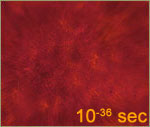 |
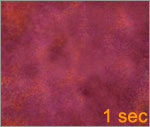 |
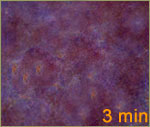 |
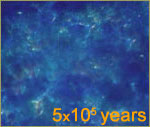 |
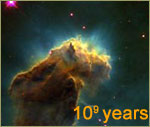 |
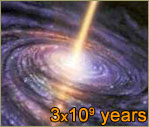 |
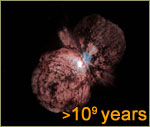 |
 |
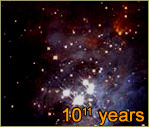 |
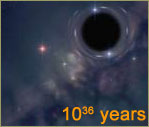 |
 |
 |
||||||||||||||||
|
"Why it is we and the universe exist? If we find the answer to this question, it would represent the ultimate triumph of human mind - for we would, then, know the mind of God." Stephen W. Hawking
|
The universe began with a vast explosion that generated space and time, and created all the matter and energy in the universe. At the big bang itself, the universe is thought to have had a zero size, therefore it should have been infinitely hot. Astronomers believe that the big bang involved a runaway process called "inflation," in which a peculiar type of energy that existed in the vacuum of space was suddenly mobilized. The inflationary expansion ended only when this energy was transformed into more familiar forms of matter and energy. |
After inflation ended in the first tiny fraction of a second, the universe continued to expand but not nearly so quickly. As the universe expanded, the temperature of the radiation decreased. One second after the big bang it would have fallen to about ten thousand million degrees. At this time the universe would have contained mostly photons, electrons neutrinos and their antiparticles, together with some protons and neutrons. |
In the next few minutes, the universe as we know it took shape. As the universe continued to expand and temperature to drop, the rate at which electron/antielectron pairs were being produces in collisions would have fallen below the rate at which they were being destroyed by annihilation. Protons and neutrons would have started to combine together to produce the nuclei of atoms of deuterium, which contain one proton and one neutron. The deuterium nuclei would have combined with more protons and neutrons to form helium nuclei. |
In some regions, slightly denser than average, the expansion would have been slowed down by the extra gravitational attraction. This would eventually stop expansion in some regions and cause them to start to re collapse. Eventually when a region got small enough it would be spinning to balance the gravity (disklike galaxies were formed). Other regions which did not pick the rotation , would become oval shaped (elliptical galaxies). |
The hydrogen and helium gas in the galaxies would break into small clouds that would collapse under their own gravity. As these contracted, and the atoms within them collided with one another, the temperature of gas will increase, until eventually it would become hot enough to start nuclear fusion reactions. The stars were born. |
From one billion to three billion years after the Big Bang many smaller galaxies merged into larger ones, forming an array of shapes resembling spirals and spheres (known as elliptical galaxies). Often, the merger was so violent that stars and gas collapsed into a common center, becoming so dense they formed gigantic black holes. The gas flowing into these black holes became hot enough to glow brightly before it disappeared. The light of these "quasars" can be seen across the depths of the universe. |
Within galaxies, as stars were being born, others died...often in enormous cataclysmic explosions. These explosions, called supernovae, are important to the evolution of galaxies because they distribute all the common elements such as oxygen, carbon, nitrogen, calcium, and iron into interstellar space. These elements will latter form the building blocks of life. |
The Sun formed within a cloud of gas in a spiral arm of the Milky Way galaxy. A vast disk of gas and debris that swirled around this new star coalesced into planets, moons, and asteroids. In time, on one of these planets, from stellar dust life evolved. Homo Sapiens was born. You and Me... |
During this era, which will last from 100 million years to one trillion years after the Big Bang (and is the era we are currently in), most of the energy generated by the universe will be in the form of stars burning hydrogen and other elements in their cores. This long period will give way to an even longer, lingering death for our universe. |
This era extends to ten trillion trillion trillion years after the Big Bang. Most of the mass that we can currently see in the universe will be contained in stars that have blown up and collapsed into black holes and neutron stars. Or it will be locked up in brown dwarfs and planets that never triggered nuclear fusion, or in stars that withered into white dwarfs. With stars no longer actively burning, energy in this era is generated through proton decay and particle annihilation. |
This era extends to ten thousand trillion trillion trillion trillion trillion trillion trillion trillion years after the Big Bang. After the epoch of proton decay, the only star-like objects remaining are black holes of widely varying masses. Their energy is steadily evaporating. |
At this late stage, protons will have decayed and black holes will have almost completely evaporated. Only the byproducts of these processes remain: mostly neutrinos, electrons, positrons, and photons of enormous wavelengths. For all intents and purposes, the universe as we know it will have come to an end. |
